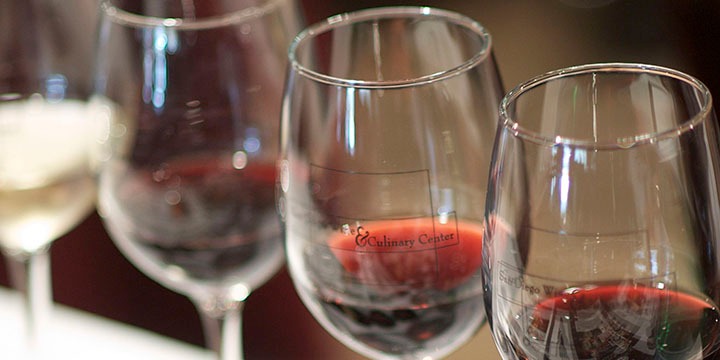Note :: I was hired to do this pairing for a specialty-food distributor’s holiday party for vendors and customers.
It will come as a surprise to no-one that I am a contrarian when it comes to wine and chocolate pairings. I generally find it easier to discover really good pairings between white wines and dark chocolates and red wines with milk chocolates.
To generalize even more widely, I find that the cliché advice, “red wines go with red meat, white wines go with fish” means you’re unlikely to get real dud pairings. But, because they’re safe, you rarely get phenomenal or sublime pairings unless you get really lucky.
By pairing outside the lines you’re more likely to run into some real loser pairings but you’re also more likely to run into truly excellent combinations.
Because I was under the gun to do the pairings (I had never tasted any of the wines before), applying the contrarian approach suited me just fine, and gave me an interesting angle to talk with the guests about – that a little bit of adventure is a good thing, and tasting outside the plate can deliver some truly excellent experiences.
The Pairings
Tanariva :: One of the two surprise pairing of the evening was the Tanariva with Brooklyn Brewery’s Pennant Ale. Pennant is an English Pale, not an IPA, and has a warm yeasty/bready flavor – lots of roasty malt flavors with a nice soft bubble structure. These married very well with the sweet caramel notes of the Tanariva and was a pairing that elevated both of the component parts. The paired wine was the Domaine Pelaqui Côtes-du-Rhône (2009). This is a good mid-priced bottle that has definite bright acidity to it. This acidity made it unpleasant with all of the dark chocolates, but the high milk fat content of the chocolate tamed the acidity of the wine nicely.
Jivara :: I also paired the Brooklyn Brewery Pennant Ale and the Côtes-du-Rhone with the Jivara. The beer pairing was not as sublime with the Jivara as the Tanariva because of the much darker flavor profile of the chocolate. However, the Jivara stood up to the Côtes-du-Rhône better than the Tanariva for the same reason.
Caraibe :: The tasting notes on the Caraibe say “balanced and voluptuous” and it was this that suggested pairing it with the Edmeades Zinfandel (California, 2009) after I got a chance to taste it – a balanced, voluptuous Zin. This is definitely a go-to comfort pairing and might just be one of the all-around most pleasant red wine and dark chocolate pairings I’ve tasted in a long time.
Alpaco :: The tasting notes on the box say “floral and oaky” and this made it a natural choice to at least try pairing with the Channing Daughters Scuttlehole Chardonnay (Long Island, NY, 2010). This chard is fermented in steel with no malolactic fermentation and there is no contact with oak. The wine is a straightforward expression of the fruit of the grape without any herbaceous or woodiness. The light floral notes of the chocolate accentuated the fruitiness while the oaky notes added a small hint of the wood we Americans have come to expect from Chardonnays, especially highly-rated Californian ones.
Manjari :: This was the other really surprising (to me) winner pairing of the evening. The combination of Manjari – which is probably the best-known Valrhona chocolate in the professional kitchen – and the Salmon Run Riesling (Finger Lakes, NY, 2010) delivered the uncanny taste impression of a s’more or at least the combination of graham cracker and chocolate. Astonishing. There is nothing about the typical Madagascan acidity or the light sweetness of the Riesling (a little too sweet for my taste, while I like Rieslings I prefer drier ones in part because it’s hard to get people who say they don’t like Rieslings to even try them during tastings – almost as hard as getting people who say they don’t like milk chocolate to try milk chocolate) to suggest that the pairing of the two would lead to graham crackers. This pairing was a lot of fun and had people smiling.
Abinao :: At 85%, this is a chocolate that even dark chocolate-lover sometimes have trouble with. Neither of the red wines came close to being a pleasant combination, the Chardonnay didn’t have enough character, and the Riesling wasn’t sweet enough. Thankfully, we had the Smith Woodhouse 10yr Tawny Port and the mellow silky sweetness of the Port blended tamed the Abinao very nicely. This would be a very good dessert pairing for following a meal where steak was the centerpiece and you didn’t want something too rich – or too sweet – for dessert.
There were two other beverages poured, Brooklyn Brewery’s Dark Chocolate Stout, and the Althea Prosecco (Italy, NV). Prosecco is my go to all-around favorite sparkling wine style for pairing, especially drier ones (although there are some stunning rosés). Proseccos have a tendency to be less sharp and alcoholic tasting than champagnes, and also tend to have a softer, creamier, bubble structure. This makes them excellent sparkling wines for general enjoyment.
The best chocolate pairings were with the Jivara, Caraibe, and Abinao. What to say about Dark Chocolate Stout but to say that it’s a no brainer for most people when it comes to chocolate pairings.
Overall, however, you want to pair a stout like this with chocolates that aren’t particularly fruity or acidic. The Caraibe was the overall best pairing because of it’s balanced flavor profile and luxurious mouth feel. The Jivara was next-best, but the Tanariva was just too sweet.
Photo credit: Story Header Image – Fast Forward Event Productions [CC BY 2.0] via Wikimedia Commons.
